
How to Prepare Your Bike for Winter
By Anna Jones at Eversure,
22 October 2024, 10 min read
The bitter cold, reduced hours of daylight and generally miserable weather in the winter months means cycling during this time of year is particularly tough, and dangerous. Slippery surfaces, both on the road and on trails, and heightened levels of biting wind are something to be aware of before tackling those winter bike rides.
As the weather gets harsher, there are a few cycling non-negotiables that make the cold more bearable, like gloves, jackets and appropriate shoes. However, as well as making sure you are prepared by being appropriately dressed, you must also prepare your bike so it can withstand adverse conditions. This guide tells you how to protect your p(ride) and joy from needless wear and extend its lifespan. Get bike insurance with us today and be covered in the event of accidental damage!
Pre-Ride – These are the things we recommend you do or check before going out
Winter Ready Tyres
Whether you are a road rider or prefer trails, you will need durable tyres with excellent grip to reduce the possibility of punctures that are more likely in winter as rain washes dirt and debris onto the surface. There is nothing worse than fixing a puncture in the cold rain so make the swap now! If in any doubt remember: roads slippy? Tyres grippy ✓
Bright Bike Lights
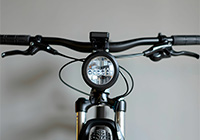
Even if you do not plan to cycle in the dark, mornings in winter can be gloomy and the sun is often low, or you could be caught out.
It is a legal requirement when cycling in the dark to have a white front and rear red light. Fix a light permanently to your bike over winter and choose one appropriate for your preferred riding style, considering if you need to see or be seen.
Commuters in well-lit urban areas need lights to help you be seen; off-roaders and trail cyclists will need powerful lights for seeing.
Mudguards
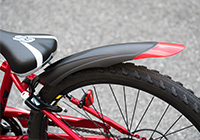
A mudguard (or a fender) prevents road spray coming off your wheels and onto you or fellow cyclists. They also protect parts of your bike from the winter grit and dirt that will reduce your bike’s lifespan.
Typically, the longer the guard the greater the coverage and protection however the mudguard you choose needs to be compatible with your bike model.
If you don’t have eyelets built into the frame where a bolt-on mudguard could be fitted or have enough clearance between the frame and the wheel, you need to look at clip-on guards.
Oil It Up
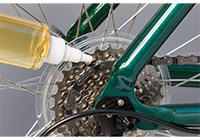
A squeaky, creaky drivetrain is the sound of a dirty chain. Having a rusty or grinding chain reduces the longevity of the drivetrain as well as the efficiency of your ride. You can avoid this by coating your chain in bike chain lubricant. In winter, you should swap to a wetter lubricant with more staying power.
Clean, dry and degrease your chain before applying the lubricant. Then, rotate the cranks backwards as you tilt the bottle onto the middle of the chain link. Allow it to settle before wiping off any excess.
Note: over oiling your chain will attract more dirt and grit from the road – it will turn it to a sandpaper-like paste that will grind down your parts as you cycle.
Gear and brake cables also need to be kept well-oiled so they can run smoothly in their outers.
The headset, bottom bracket, hubs, freewheel, rim-brake pivots, pedal axles and releases also all need to be lubricated.
Saddle Bags
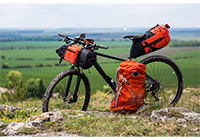
Carrying essential tools for repair is sensible as you don’t want to be stranded on the side of the road at the best of times let alone in harsh winter conditions. We suggest you pack:
Extra tubes
Multitool
Chain tool
Inflation device (CO2 cannister, hand pump)
Frame pump
Snacks
Cash
ICE details
Post-Ride – These are the things we recommend you do or check once you come back
Keep it Clean
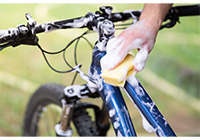
Your bike will need to be cleaned after rides in the winter but the reasons for this go beyond aesthetics. Maintaining your bike’s cleanliness will stop moisture and salt from corroding parts.
As dirt and lubricant combine to generate an abrasive paste you must be diligent about cleaning your chain and gears more thoroughly in winter.
Be aware that sealed in components can be affected by dirt and water which will then affect your ability to stop or shift gears in a timely fashion.
Investing in a bike protection spray will increase its water resistance and help keep the components and frame cleaner for longer.
Even with mudguards, your bike will get dirty. Remember, a clean bike is a fast bike.
Store it Away & Insure it Today!
The best thing you can do for your bike is to keep it indoors where it is dry and at a constant temperature. As the bike is not exposed to the elements it means that it is less likely to rust or corrode and so its lifespan will increase.
Finally, don’t forget to insure your bike with us today!
We hope these tips come in handy when you are getting your bike ready for winter. Enjoy the beautiful scenery that British winters can offer and happy cycling!